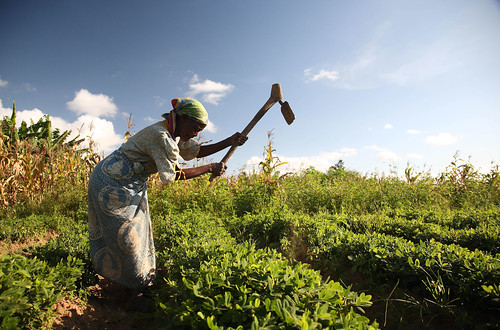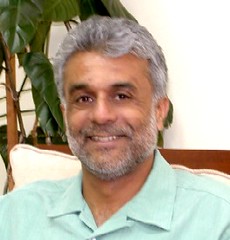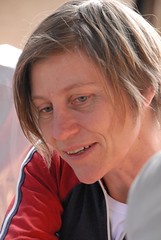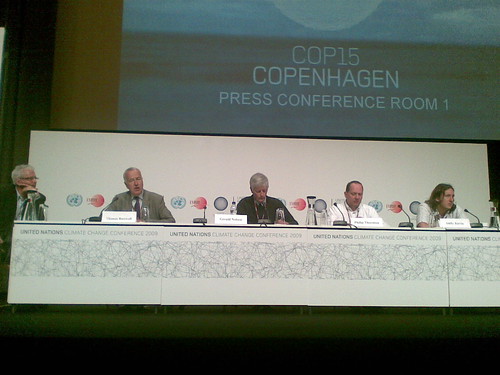Agricultural systems analyst Mario Herrero (Cost Rica), based at the Nairobi, Kenya, campus of the International Livestock Research Institute (ILRI), this July-August 2010 hosted a 'write-shop cum think tank' session with a group of leading world experts on the topic of food systems, particularly those involving meat, milk and eggs, and climate change.
Eight short filmed interviews of 4 of these experts on the following topics are posted on www.ilri.blip.tv. Click on the links below to view the interviews.
(1) From cows to camels: adapting to Africa’s drying climates
Ilona Glücks: Vétérinaires sans frontières (VSF), Switzerland
Many of Africa’s grazing lands are becoming drier with climate change. Some pastoral communities that have traditionally herded cattle, sheep and goats across these lands are switching to camels. Camels produce milk for longer than cattle, maintaining production even during prolonged dry seasons and droughts. Researchers expect that camels will become increasingly common and important to the economic and nutritional well-being of Africa’s pastoral households.
(2) Will deforestation remain the biggest driver of human-induced global warming?
Michael Obersteiner: International Institute for Applied Systems Analysis (IIASA), Austria
Deforestation historically has been the largest producer of human-generated greenhouse gases. Recent experience suggests that global deforestation trends can be reversed. Since 2002, for example, Brazil has virtually stopped the clearing of forests on a massive scale to make room for livestock grazing.
(3) We can reduce global warming through our food chains
Tara Garnett: Food Climate Research Network, University of Surrey, UK
Significant amounts of greenhouse gas produced by humans are generated by the growing, processing, distribution and sale of food. Much can be done to reduce the levels of greenhouse gases in our food chains.
(4) We need to find equitable ways to reduce greenhouse gases
Tara Garnett: Food Climate Research Network, University of Surrey, UK
Scientists report that we need to reduce our greenhouse gas emissions by up to 80 per cent by 2050. Research shows ways to reduce emissions from the agricultural sector, which generates a large amount of the carbon dioxide and other greenhouse gases produced by humans. Policies to support such reductions must to take into account the different needs and circumstances of developed and developing nations.
(5) Will vegetarianism reduce global warming?
Tara Garnett: Food Climate Research Network, University of Surrey, UK
While changes need to be made to address growing problems of obesity and diet-based ill health in rich countries, animal products will remain vital to the nutrition of poor people in poor countries, where consumption of milk, meat and eggs is about a tenth the rate of that in rich countries. Whole populations becoming vegetarian or vegan will help neither the overfed nor underfed.
(6) How much land should be converted from foods to bio-fuels?
Tim Searchinger: Princeton University, USA
With land becoming increasingly scarce, converting lots of farms to grow crops for bio-fuels rather than food could reduce our food supplies and drive up food prices. Most of the world’s arable land now being used to grow food should not be converted for bio-fuel production. Rather, unused lands and non-food crops or waste biomass (e.g., inedible cereal stalks) should be sought for bio-fuel production.
(7) Should we curtail livestock or biofuel production to slow global warming?
Tim Searchinger: Princeton University, USA
Livestock enterprises today produce more greenhouse gases than the production of fuels derived from biomass; that’s because livestock keeping is still so much more common than bio-fuel production. But policies to curtail livestock production in poor countries would harm the poor. Livestock are the nutritional and economic mainstay of some one billion poor people today, and are likely only to increase in importance as the global human population grows to more than 9 billion by mid-century.
(8) Will we ever run our cars on bio-fuels?
Tim Searchinger: Princeton University, USA
One day we will probably grow enough bio-fuels to power airplanes. It is unlikely, however, that we shall ever produce bio-fuels at scales sufficiently large to replace petrol for our cars.





 The Swedish-funded BioInnovate Africa program today launched a call for concept notes on “Adapting to Climate Change in Agriculture and the Environment in Eastern Africa.”
The Swedish-funded BioInnovate Africa program today launched a call for concept notes on “Adapting to Climate Change in Agriculture and the Environment in Eastern Africa.”


